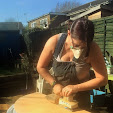Warning: this post contains a lot about my favourite sport (rugby union).
About half my lifetime ago, probably even less, if you had unloaded a rugby union team off a coach in front of me, I'd have had a pretty good chance of identifying the position of every player without needing to see the numbers on their backs.
Don't believe me? Watch me. Rugby is in my blood.
- Anybody with cauliflower ears is pretty certain to be a forward (# 1 to 8), and will be involved in the scrum. Let's look at them first.
- Those two Sherman tanks are almost certainly the props, (# 1 and 3). They will be the ones who prop up the hooker (more of him next) in the front row of the scrum. Don't expect much speed from them, but don't get in their way, either. They will charge right over you. Or through you. The one with two cauliflower ears is the tighthead. The one with only one cauliflower ear is the loosehead.
- That square block of a man with no neck and a crazy glint in his eye, is the hooker (#2, known in the US as 'hook'). He has got to be a bit nuts (not unlike the guy who counters instinct to fling himself into the path of an oncoming hockey puck) - he gets picked up by the two biggest guys on the team and shoved face first into a pack of 8 opposing beefcakes bent on destruction.
- Those two giants? Well, they'll be the locks (#4 and 5). They also form part of the scrum, hence their heft, but they are also great jumpers who will try to win the ball during lineouts.
- Those two slightly shorter guys, with the great musculature are probably the flankers, (#6 and 7), aka wing forwards. They'll be pretty quick on their feet, but not the fastest by a long shot. They'll probably be first away from the scrum when the ball comes out.
- But hang on. We still have one big guy here. Well, he'll be the eighth man (#8, obviously enough). A bit like the running back in American football. He is quite often also tall and fairly quick for a big guy, and will be off after the flankers when the scrum breaks up. He'll be one of the first on the scene when there's a ruck.
- Now we come to the littlest guy on the team. In days gone by, this guy could be really titchy. But quick and slippery, like a wet bar of soap. This is your scrum half. This is a guy with a real rugby brain. He sees the bigger picture. He gets the ball from the forwards to the backs (where the speed is). Every time there is a scrum, a ruck or a maul, a good scrum half will be right there. He gets the ball out and feeds it to the team whippets, who come next.
- Those lean guys, built like 100m sprinters? Those are your wings. #11 is your left wing, #14 on the right. These guys can run like the wind, and have an awesome side-step. These are the guys to whom to the scrum half will be looking to pass the ball, because they have the best chance of outrunning the opposition and making it to the try line. If you were picking yourself a dance partner for the prom, these were the guys to go for - they'd be the best on their feet... and they're often the best looking guys on the team, anyway!
- The guys who are most difficult to classify on appearances alone (for me, at any rate) are #10, 12, 13 and 15. You'll know they're not forwards, because they're not so beefy. They might even be as good looking as the wings. They look as if they could be pretty quick, too. They are, in numerical order, the fly half, the two centres and the full back.
These days, the back line seems to have beefed up. The forwards are often deceptively quick. The scrum half (with a few notable exceptions, such as Ireland's Peter Stringer) is no longer diminutive. Increasingly, team members play out of position to cover for one another.
Is it such a stretch to say that this is what I think has happened, or is beginning to happen in some cases, in the workplace?
People have become adept at using the technology that used to be the province of the IT team. Individuals collaborate without needing to be instructed by their managers to do so, or with whom to do so. People have identified experts within different arenas within the business and are quite happy to go to them for help rather than approach the L&D team.
It takes one set of skills to train a rugby team of uni-disciplinary specialists, it takes an entirely different mindset to train a team full of players prepared to have a go anywhere on the field, should that prove necessary.
In the same way, I reckon we need to be looking to the skill sets traditionally required by management and the L&D team, and consider how different these need to be going forward, with a bunch of people far more comfortable at thinking on the fly and adapting to changed parameters as necessary.


No comments:
Post a Comment